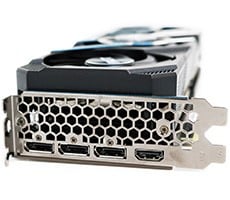BIOS and Overclocking - MSI K9N Diamond
|
|
|
Equipped with a BIOS from American Megatrends, Inc, the K9N Diamond supplies a decent collection of options along with a user friendly interface. The key performance options for the K9N Diamond are located under two menus, the Cell Menu and Advanced Chipset Features. The Cell Menu is the first place to go for all things related to overclocking. Here the CPU, PCI and Memory can be adjusted for frequency, timings and voltages.
The most configurable component was the CPU. The CPU Frequency was adjustable from 200-500MHz with a multiplier range of 5-12x. The Adjust Extra CPU Voltage allowed for added CPU voltage from .05v through .30v on .05 steps. MSI also offered a Dynamic Overclock option that sets system overclock settings on the fly, a plus for novices looking for a quick overclock without the hassle of manual experimentation. The Dynamic Overclock ranged from Private (1%), Sergeant (3%), Captain (5%), Colonel (7%) and General (10%). On a side note, for those looking for more power but need a little guidance with the intricacies of overclocking, NVIDIA has a decent write up located here which is specifically written for the 590 SLI.
The DDR2 memory options were ample, although nowhere near as comprehensive as the ASUS M2N32 WS Pro. The frequency could be set for 400, 533, 667 and 800 MHZ as well as Auto. The voltage options ranged from 1.7-2.30v in .05v increments. All of the timing options were located under the Memory Configuration menu. By default, the timings are set to Auto, however, when changed to Manual, a series of other choices appear. CAS Latency was adjustable in increments of 1 from 3-5. Min RAS Active Time ranged from 5-18 while RAS Precharge Time NS and RAS to CAS Delay both ranged from 3, 4, 5 and 6.
PCI Express Frequency was adjustable from 100MHz to a maximum of 148.4375MHz. There were also voltage adjustments for CPU to Northbridge, Southbridge to PCIE, Northbridge to SouthBridge HT and Northbridge to PCIE. When we shift focus to the Advanced Chipset Features Menu, this is where HyperTransport Link frequency adjustments were available. Here the CPU to Northbridge, Northbridge to Southbridge and Southbridge to Northbridge could all be individually set for 200, 400, 600, 800 and 1000MHz. Additionally, the link between the Northbridge and CPU as well as Northbridge and Southbridge could be manually set for either 16 or 8 lanes.
Overall, the BIOS that drives the K9N Diamond is well equipped, however, organization could be improved. At times we had to drill down three menus deep to access certain options, which was a minor annoyance.
|
|
|
Overclocking the MSI K9N Diamond was a positive experience. Like the other two systems, we locked the memory at 400MHz and dropped the CPU multiplier to x5. Next, we started raising the CPU frequency until the system would no longer post, then backing off until we could boot into Windows.

|

|
|
Max Overclock 4X HT Link 390MHz |
Max Overclock 5X HT Link 298MHz |
With the K9N Diamond, our peak result was 298MHz with CPU voltage running at 1.3v and the HT Link locked at x5. Next, the CPU multiplier was raised to test the maximum CPU speed at these settings. The highest setting we reached was x9, pushing the CPU from 2.4GHz to 2.68GHz.
Next, the HT Link was locked at x4, CPU clock set at x5 and the CPU frequency was raised beyond 298MHz to see just how high we could go. This time around, the system returned an impressive peak of 390MHz, adding 92MHz to our initial overclock, however, unlike the previous two boards, raising the multiplier to x6 did not result in a bad overclock. In fact, a multiplier setting of x7 even worked, pushing the CPU speed to 2.74GHz. The system did ultimately lock up at x8, proving that 3.12GHz was too much to ask for this processor.
In our final test, the HT Link was set back to Auto, the CPU multiplier set to its default x12, the CPU clock returned to 200MHz and then slowly raised. In this test, we reached similar results to the other three boards, topping out at 232MHz CPU clock, resulting in the CPU running at 2.78GHz.






